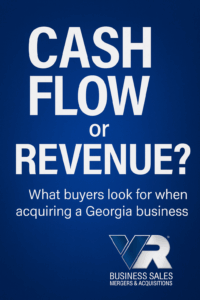Many Georgia business owners believe the size of their revenue tells the story of their value. The bigger the number at the top of the financial statement, the better. But when it’s time to sell, buyers and banks look much deeper.
Revenue is a headline. Cash flow is the whole story.
Why Buyers Put Cash Flow First
-
Revenue is vanity. A $5M revenue business that barely breaks even is not impressive to a buyer.
-
Cash flow is reality. Buyers want to see what’s left after expenses because that’s what pays loans, salaries, and growth.
-
Financing follows earnings. Lenders don’t approve deals on revenue—they approve them on the ability of cash flow to support debt payments comfortably.
Example 1: The $6M Restaurant Group vs. the $2.5M IT Firm
An Atlanta restaurant group came to market with $6M in sales. On paper, it looked big. But high labor costs, food inflation, and seasonal swings left just $400K in real earnings. Buyers valued the company around $1.6M.
At the same time, a much smaller IT services firm with $2.5M in revenue showed $900K in clean, recurring cash flow from managed contracts. Buyers lined up and the business closed at roughly $3.6M—over twice the valuation of the larger restaurant group.
Takeaway: Predictable, recurring earnings carry more weight than size alone.
Example 2: The $4M Distributor vs. the $1.2M HVAC Company
A wholesale distributor with $4M in annual sales seemed strong until the financials told the real story: just $350K in bottom-line cash flow after thin margins and competitive pricing pressure. Buyers put the business near $1.4M.
Meanwhile, a local HVAC company with $1.2M in sales consistently produced $500K in cash flow thanks to steady maintenance contracts and service agreements. That business sold for close to $2M—outperforming the distributor with triple the revenue.
Takeaway: Smaller but more profitable companies often earn higher valuations than larger but less efficient ones.
Why Buyers Think This Way
-
Risk: Strong cash flow lowers risk. A business that consistently pays its bills and generates surplus gives buyers confidence.
-
Growth Potential: Buyers would rather scale a smaller but profitable firm than inherit the headaches of a big, thin-margin operation.
-
Return on Investment: Cash flow is the only reliable way for buyers to calculate how quickly they’ll earn back their investment.
How Sellers Can Prepare
-
Clean up financials. Remove personal expenses and tighten reporting.
-
Stabilize earnings. Build recurring revenue streams where possible.
-
Improve profitability. Even modest margin gains can dramatically raise valuation.
-
Start early. Preparation 12–18 months ahead can add real dollars at closing.
Summary
Revenue may make for a big headline, but buyers and lenders pay for dependable earnings. In today’s Georgia market, a $2M company with strong cash flow can be worth more than a $6M business running on thin margins. To maximize value, focus on clean, predictable, and repeatable cash flow.
Q&A
Q: My sales are growing fast. Doesn’t that make me more valuable?
A: Not unless it comes with healthy profits. Buyers don’t pay for potential; they pay for proven earnings.
Q: What’s the single most important number buyers look at?
A: Seller’s Discretionary Earnings (SDE) for small to mid-sized companies. It tells the real story.
Q: Can a smaller business really sell for more than a larger one?
A: Yes. As the IT firm and HVAC examples show, higher cash flow beats higher revenue every time.



